GE GFWS1500DWW, GFWH1400DWW, GFWH1200DWW, GFWN1100DWW Owner's Manual
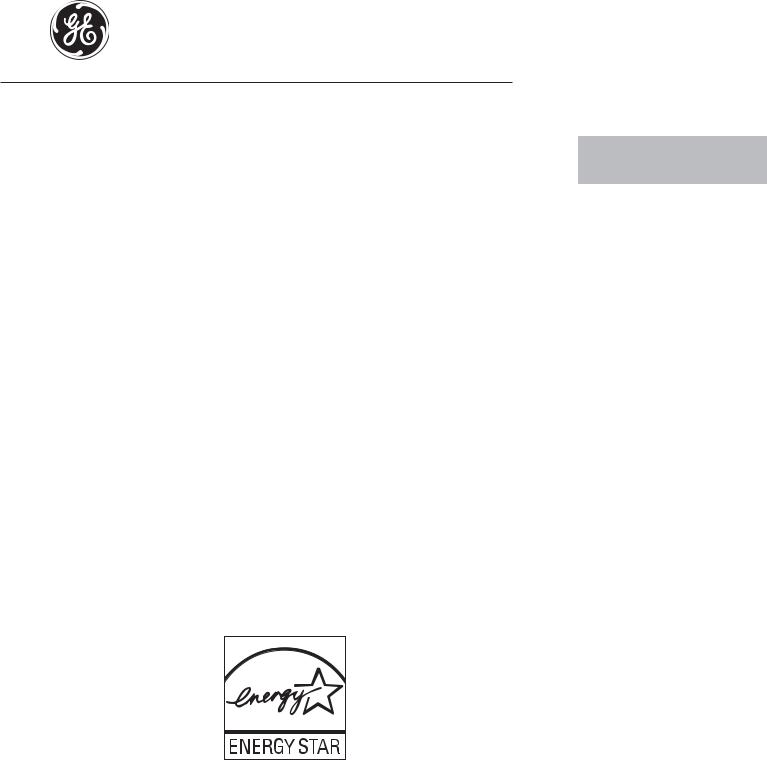
Washers
Printed in China
GEAppliances.com
Safety Instructions. . . . . . . . . . . . . . 2, 3
Operating Instructions
Control Panels . . . . . . . . . . . . . . . . . . . . . . 4-7
Features . . . . . . . . . . . . . . . . . . . . . . . . . . . . 8–9
Loading and Using the Washer . . . .10, 11
Cleaning the Washer . . . . . . . . . . . . . .12–14
Installation Instructions. . . . . .15–20 Preparing to Install Your Washer. . . . . . 15 Rough-In Dimensions. . . . . . . . . . . . . . . . . 16 Location of Your Washer . . . . . . . . . . . . . 16 Unpacking Your Washer. . . . . . . . . . . . . . 17 Drain Requirements . . . . . . . . . . . . . . . . . . 18 Electrical Requirements . . . . . . . . . . . . . . 18 Water Supply Requirements . . . . . . . . . . 18 Installing the Washer. . . . . . . . . . . . . .19, 20 Replacement Parts . . . . . . . . . . . . . . . . . . . 20
Troubleshooting Tips . . . . . . . . .21–24
Consumer Support
Warranty . . . . . . . . . . . . . . . . . . . . . . . . . . . . 25
Service Telephone Numbers . . . . . . . . . . 26
As an ENERGY STAR® partner, GE has determined that this
product meets the ENERGY STAR® guidelines for energy efficiency.
Write the model and serial numbers here:
Model # _________________
Serial # __________________
You can find them on a label on the side of the washer.
Owner’s Manual &
Installation Instructions
GFWN1100
GFWN1200
GFWH1200
GMAN1200
GFWH1300
GFWN1300
GFWH1400
GFWH1405
GFWS1500
GFWS1505
English/Français/Español
49-90454-2 06-13 GE
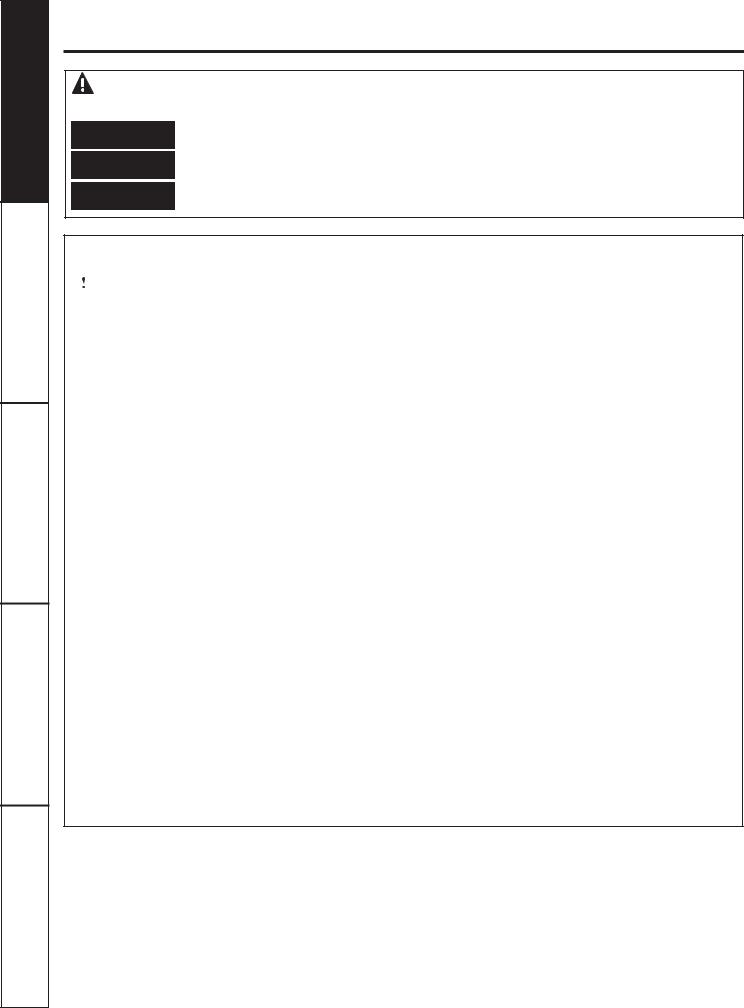
Operating Instructions Safety Instructions
Instructions
Installation
Consumer Support Troubleshooting Tips
IMPORTANT SAFETY INFORMATION.
READ ALL INSTRUCTIONS BEFORE USING.
This is the safety alert symbol. This symbol alerts you to potential hazards that can kill you or hurt you and others. All safety messages will follow the safety alert symbol and the word “DANGER”, “WARNING”, or “CAUTION”. These words are defined as:
 DANGER Indicates a hazardous situation which, if not avoided, will result in death or serious injury.
DANGER Indicates a hazardous situation which, if not avoided, will result in death or serious injury.
 WARNING Indicates a hazardous situation which, if not avoided, could result in death or serious injury.
WARNING Indicates a hazardous situation which, if not avoided, could result in death or serious injury.
 CAUTION Indicates a hazardous situation which, if not avoided, could result in minor or moderate injury.
CAUTION Indicates a hazardous situation which, if not avoided, could result in minor or moderate injury.
IMPORTANT SAFETY INSTRUCTIONS
WARNING |
To reduce the risk of death, fire, explosion, electric shock, or injury to persons when using your |
|
appliance, follow basic precautions, including the following: |
|
Read all instructions before using the appliance.
DO NOT wash or dry articles that have been previously cleaned in, washed in, soaked in or spotted with gasoline, dry-cleaning solvents, or other flammable or explosive substances, as they give off vapors that could ignite or explode.
DO NOT add gasoline, dry-cleaning solvents, or other flammable or explosive substances to the wash water. These substances give off vapors that could ignite or explode.
Under certain conditions, hydrogen gas may be produced in a hot-water system that has not been used for 2 weeks or more. HYDROGEN GAS IS EXPLOSIVE. If the hot water system has not been used for such a period, before using a washing machine, turn on all hot-water faucets and let the water flow from each for several minutes. This will release any accumulated hydrogen gas. As the gas is flammable, DO NOT smoke or use an open flame during this time.
DO NOT allow children to play on or in this appliance. Close supervision of children is necessary when this appliance is used near children. Before the washer is removed from service or discarded, remove the door or lid. Failure to follow these instructions may result in death or injury to persons.
DO NOT reach into the appliance if the tub or agitator is moving to prevent accidental entanglement.
DO NOT install or store this appliance where it will be exposed to the weather.
DO NOT tamper with controls, repair or replace any part of this appliance or attempt any servicing unless specifically recommended in the user maintenance instructions or in published user repair instructions that you understand and have the skills to carry out.
Keep the area around your appliance clean and dry to reduce the possibility of slipping.
DO NOT operate this appliance if it is damaged, malfunctioning, partially disassembled, or has missing or broken parts including a damaged cord or plug.
Unplug the appliance or turn off the circuit breaker before servicing. Pressing the Power button DOES NOT disconnect power.
See “Electrical Requirements” located in the Installation Instructions for grounding instructions.
SAVE THESE INSTRUCTIONS
2

GEAppliances.com
PROPER INSTALLATION
 This washer must be properly installed and located in accordance with the Installation Instructions before it is used. If you did not receive an Installation Instructions, you can receive one by visiting GEAppliances.com or by calling 800.GE.CARES (800.432.2737).
This washer must be properly installed and located in accordance with the Installation Instructions before it is used. If you did not receive an Installation Instructions, you can receive one by visiting GEAppliances.com or by calling 800.GE.CARES (800.432.2737).
Ensure that the hot water hose is connected to the “H” (internal red screened) valve and the cold water hose is connected to the “C” (internal blue screened) valve.
Install or store where it will not be exposed to temperatures below freezing or exposed to the weather, which could cause permanent damage and invalidate the warranty.
Properly ground washer to conform with all governing codes and ordinances. Follow details in Installation Instructions.
 WARNING
WARNING  - Electrical Shock Hazard
- Electrical Shock Hazard
Plug into a grounded 3 prong outlet. DO NOT remove ground prong.
DO NOT use an adapter.
DO NOT use an extension cord.
Failure to do so can result in death, fire or electrical shock.
This washer does not include water supply hoses.
GE strongly recommends the use of factory specified parts. A list of factory hoses available for purchase are listed below. These hoses are manufactured and tested to meet GE specifications.
GE strongly recommends the use of new water supply hoses. Hoses degrade over time and need to be replaced every 5 years to reduce the risk of hose failures and water damage.
Parts and Accessories
Order on-line at GEApplianceparts.com today, 24 hours a day or by phone at 800.626.2002 during normal business hours.
Part Number |
Accessory |
PM14X10002 |
4 ft Rubber Water Supply Hoses |
Or |
|
PM14X10005 |
4 ft Braided Metal Water Supply Hoses |
WX10X10011 |
Tide® Washing Machine Cleaner* |
WX7X1 |
Washer Floor Tray |
WHEN NOT IN USE
Turn off water faucets to minimize leakage if a break or rupture should occur. Check the condition of the fill hoses; GE recommends changing the hoses every 5 years.
SAVE THESE INSTRUCTIONS
* Tide® is a registered trademark of Procter & Gamble |
3 |
|
Instructions Operating Instructions Safety
Installation
Instructions
Support Consumer Tips Troubleshooting
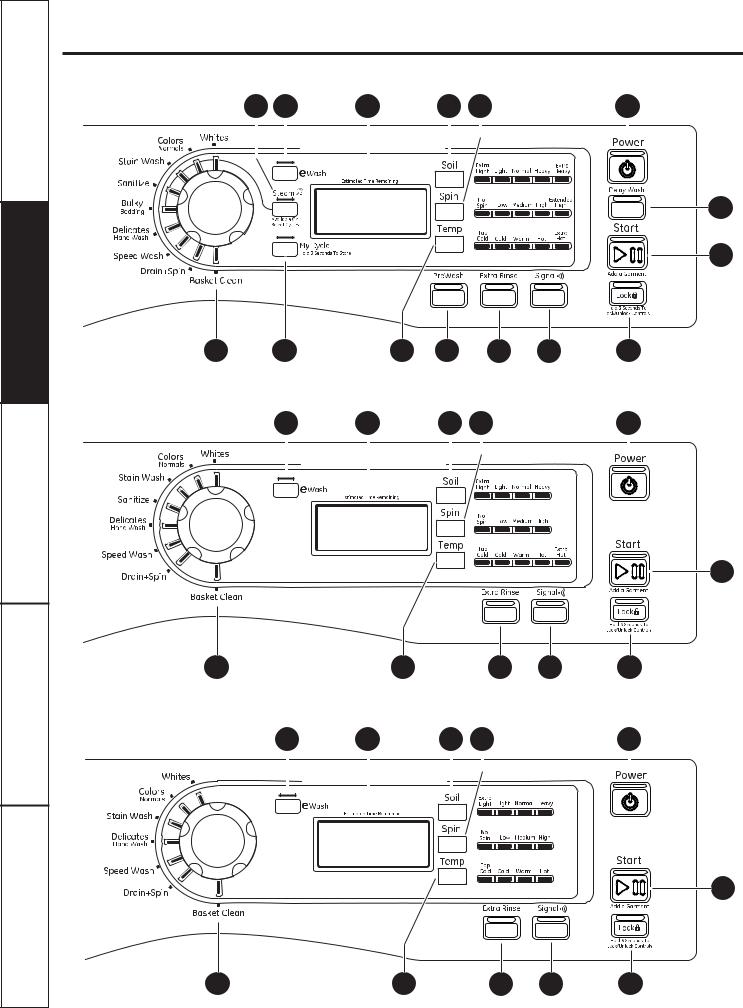
Operating Instructions Safety Instructions
Instructions
Installation
Consumer Support Troubleshooting Tips
About the washer control panel.
Find the illustration that closely matches your model and see the descriptions for details.
14 13 |
15 |
3 |
4 |
1 |
||||||
|
|
|
|
|
|
|
|
|
|
|
|
|
|
|
|
|
|
|
|
|
|
|
|
|
|
|
|
|
|
|
|
|
|
|
|
|
|
|
|
|
|
|
|
|
|
|
|
|
|
|
|
|
|
|
|
|
|
|
|
|
|
|
|
|
|
10
6
2 |
12 |
|
|
5 |
8 |
9 |
7 |
11 |
|||||
|
13 |
15 |
|
3 |
4 |
|
1 |
||||||
|
|
|
|
|
|
|
|
|
|
|
|
|
|
|
|
|
|
|
|
|
|
|
|
|
|
|
|
|
|
|
|
|
|
|
|
|
|
|
|
|
|
|
|
|
|
|
|
|
|
|
|
|
|
|
|
|
|
|
|
|
|
|
|
|
|
|
|
|
|
|
|
|
|
|
|
|
|
|
|
|
|
|
|
6
2 |
|
|
|
5 |
|
|
|
|
9 |
7 |
11 |
|
13 |
15 |
3 |
4 |
|
|
1 |
||||||
|
|
|
|
|
|
|
|
|
|
|
|
|
|
|
|
|
|
|
|
|
|
|
|
|
|
|
|
|
|
|
|
|
|
|
|
|
|
|
|
|
|
|
|
|
|
|
|
|
|
|
|
|
|
|
|
|
|
|
|
|
|
|
|
|
|
|
|
|
|
|
|
|
|
|
|
|
|
6
4 |
2 |
5 |
9 |
7 |
11 |
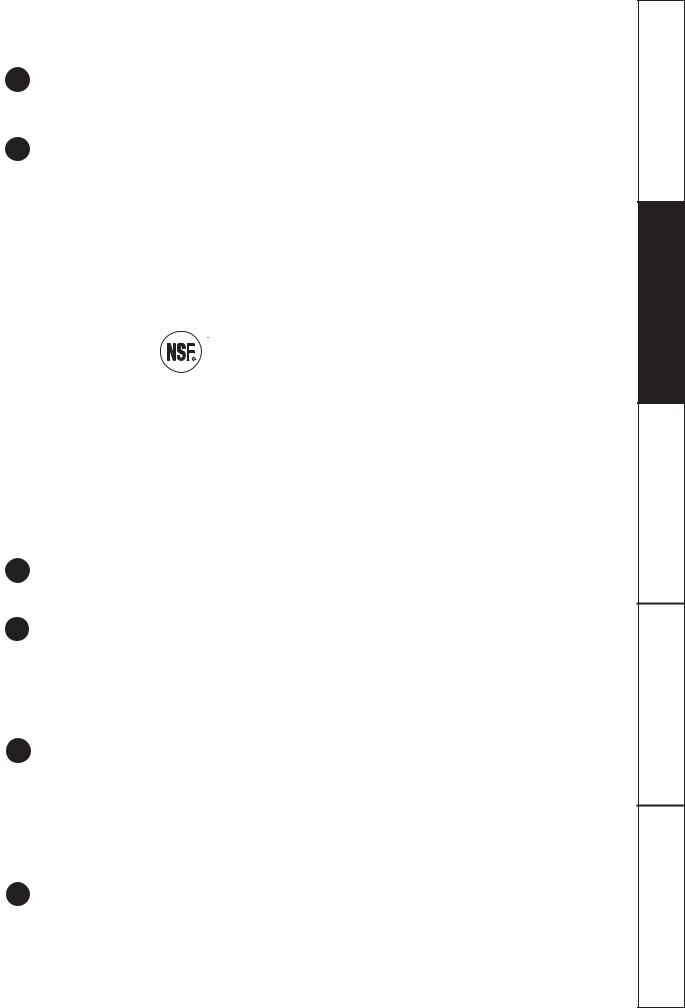
|
|
|
|
|
|
GEAppliances.com |
|
|
|
|
|
|
|
|
|
1 |
Power |
|
|
|
|
|
|
|
Press to “wake up” the display. If the display is active, press to put the washer into standby mode. |
|
|||||
|
NOTE: Pressing Power does not disconnect the appliance from the power supply. |
|
|||||
2 |
Wash Cycles |
|
|
|
|
|
|
The wash cycles are optimized for specific types of wash loads. The chart below will help you match |
|
||||||
|
the wash setting with the loads. The GentleClean™ lifters lightly tumble the clothes into the water and |
|
|||||
|
detergent solution to clean the load. |
|
|||||
|
|
|
|
|
|
|
|
|
Whites For heavily to lightly soiled white laundry. |
|
|||||
|
|
|
|
|
|
|
|
|
Colors/Normals For heavily to lightly soiled colorfast cottons, household linens, work and play |
|
|||||
|
|
clothes. |
|
||||
|
|
|
|
|
|
|
|
|
Stain Wash For heavily soiled colorfast laundry. |
|
|||||
|
|
|
|
|
|
|
|
|
Sanitize When selecting sanitize, the washer increases the water temperature to sanitize |
|
|||||
|
(on some models) |
and remove 99.9% of bacteria found in home laundry. For best results, select the |
|
||||
|
|
heavy soil setting when using the sanitize cycle. |
|
||||
|
|
|
|
|
|
|
|
|
|
|
|
|
NSF Protocol P172 |
|
|
|
|
|
|
|
Sanitization Performance of Residential and |
|
|
|
|
|
|
|
|||
|
|
|
|
|
Commercial, Family-Sized Clothes Washers |
|
|
|
|
|
|
|
|||
|
|
|
|
|
|
||
|
|
|
|
|
|
|
|
|
Bulky Bedding For large coats, bed spreads, mattress covers, sleeping bags and similar large and |
||||||
|
(on some models) |
bulky items. Large items such as blankets, comforters, jackets and small rugs. |
|
||||
|
Delicates For lingerie and special-care fabrics with light to normal soil. Provides gentle |
|
|||||
|
Hand Wash |
tumbling and soak during wash and rinse. |
|
||||
|
|
|
|
|
|
|
|
|
Speed Wash For lightly soiled items that are needed in a hurry. Cycle time is approximately |
|
|||||
|
|
30 minutes, depending on selected options. |
|
||||
|
Drain & Spin Drain and spin at any time. |
|
|||||
|
|
|
|
|
|
|
|
|
Basket Clean Use for cleaning the basket of residue and odor. Recommended use of once per month. |
|
|||||
|
|
NOTE: Never load laundry while using Basket Clean. The laundry may become |
|
||||
|
Soil Level |
damaged or contaminated. See the Care and Cleaning section. |
|
||||
3 |
|
|
|
|
|
|
|
|
Changing the Soil level increases or decreases the wash time to remove different amounts of soil. |
|
|||||
|
To change the Soil level, press the Soil level pad until you have reached the desired setting. |
|
|||||
4 |
Spin Speed |
|
|
|
|
|
|
|
Changing the Spin speed changes the final spin speed of the cycles. Always follow the fabric |
|
|||||
|
manufacturer’s care label when changing the spin speed. |
|
|||||
|
To change the spin speed, press the Spin speed pad until you have reached the desired setting. Higher |
||||||
|
spin speeds are not available on certain cycles, such as Delicates. |
|
|||||
|
Higher spin speeds remove more water from the clothes and will help reduce dry time, but may also |
|
|||||
|
increase the possibility of setting wrinkles on some fabrics. |
|
|||||
5 |
Wash Temp |
|
|
|
|
|
|
|
Adjust to select the proper water temperature for the wash cycle. The prewash and rinse water is |
|
|||||
|
always cold to help reduce energy usage and reduce setting of stains and wrinkles. |
|
|||||
|
Follow the fabric manufacturer’s care label when selecting the wash temperature. |
|
|||||
|
To change the wash temperature, press the Wash Temp pad until you have reached the desired |
|
|||||
|
setting. |
|
|
|
|
|
|
|
NOTE: The first 10 seconds of the wash fill is always cold. This feature assists in conditioning the fabric |
||||||
|
and preventing stains from setting on garments. |
|
|||||
6 |
Start/Add a Garment |
|
|||||
|
Press to start a wash cycle. If the washer is running, pressing it once will pause the washer and unlock |
||||||
|
the door. Press again to restart the wash cycle. |
|
|||||
|
NOTE: If the washer is paused and the cycle is not restarted within 2 hours, the current wash cycle will |
||||||
|
be cancelled. |
|
|
|
|
|
|
|
NOTE: The washer performs automatic system checks after pressing the Start pad. Water will flow |
5 |
|||||
|
in 45 seconds or less. You may hear the door lock and unlock before water flows; this is normal. |
||||||
Instructions Operating Instructions Safety
Installation
Instructions
Support Consumer Tips Troubleshooting
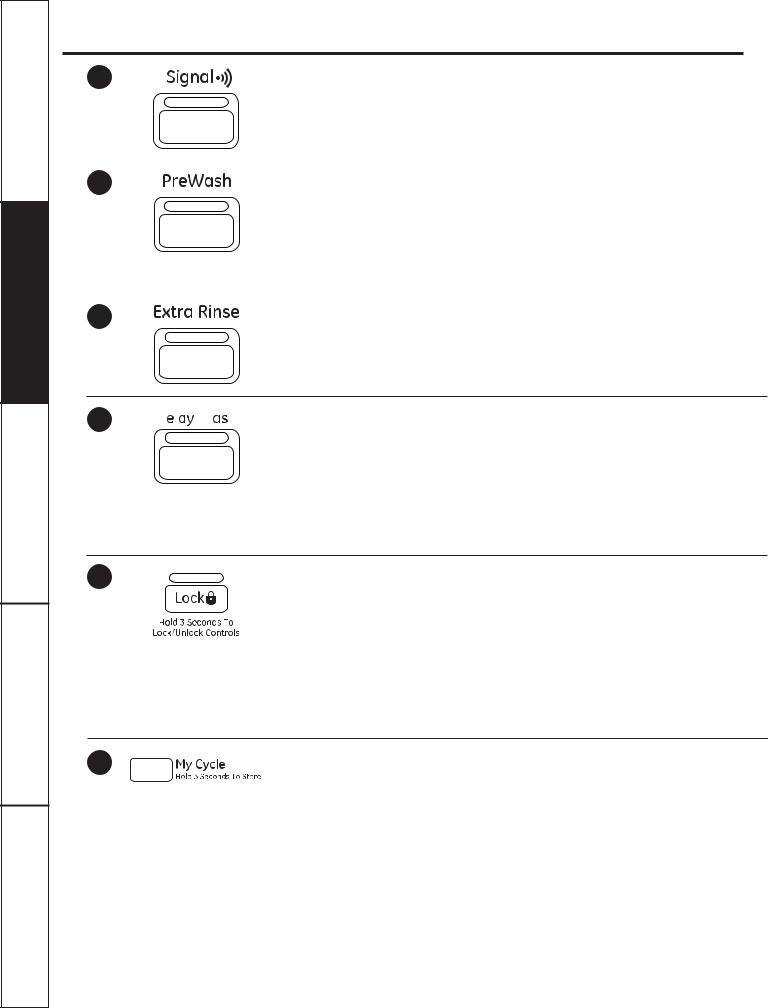
Operating Instructions Safety Instructions
Instructions
Installation
Consumer Support Troubleshooting Tips
About the washer control panel.
7 |
Cycle Signal |
Press the pad until you reach |
|
Use the Signal pad to change |
|
|
the volume of the end of cycle signal. |
the desired volume. |
|
|
|
8 |
Prewash (on some models) |
detergent, or the proper wash additive |
|
Prewash is an extra wash before |
|
|
the main wash. Use it for heavily soiled |
to the prewash dispenser. |
|
clothes or for clothes with a care label |
NOTE: When selecting prewash, |
|
that recommends prewashing before |
|
|
it is recommended to use powder |
|
|
washing. Be sure to add high-efficiency |
|
|
detergent in the main wash (detergent) |
|
|
|
|
|
|
compartment. |
|
|
|
9 |
Extra Rinse |
|
Use an extra rinse when additional rinsing is desired to remove excess dirt and detergent from soiled loads.
10 


 Delay Wash (on some models)
Delay Wash (on some models)
You can delay the start of a wash cycle for 10–18 hours, depending on the model. Press the Delay Wash pad to choose the number of hours you want to delay
the start of the cycle, then press the Start pad. The machine will count down and start automatically at the correct time.
NOTE: If you forget to fully close the door, a reminder signal will beep reminding you to do so.
NOTE: If you open the door when the delay is counting down, the machine will enter the pause state. You must close the door
and press Start again in order to restart the countdown.
11  Lock
Lock
You can lock the controls to prevent any selections from being made. Or you can lock the controls after you have started
a cycle.
Children cannot accidentally start the washer by touching pads with this option selected.
To lock the washer controls, press and hold the Lock pad for 3 seconds.
To unlock the washer controls, press and hold the Lock pad for 3 seconds.
The control lock icon on the display will light up when it is on.
NOTE: The Power pad can still be used when the machine is locked.
12 |
|
My Cycle (on some models) |
|
||
|
||
|
To save a favorite cycle, set the desired |
|
|
|
|
|
|
settings for wash cycle, soil level, spin speed |
|
|
and wash temp settings and hold down |
|
|
the My Cycle pad for 3 seconds. A beep will |
|
|
sound to indicate the cycle has been saved. |
|
|
To use your custom cycle, press the |
|
|
My Cycle pad before washing a load. |
|
|
To change the saved cycle, set the desired |
|
|
settings and hold down the My Cycle pad |
|
|
for 3 seconds. |
NOTE: When using My Cycle, wash options cannot be modified after the cycle has been started.
NOTE: If you change wash options with My Cycle before starting the cycle, the
My Cycle OLJKW ZLOO WXUQ RȺ DQG \RX ZLOO be returned to the base cycle.
6
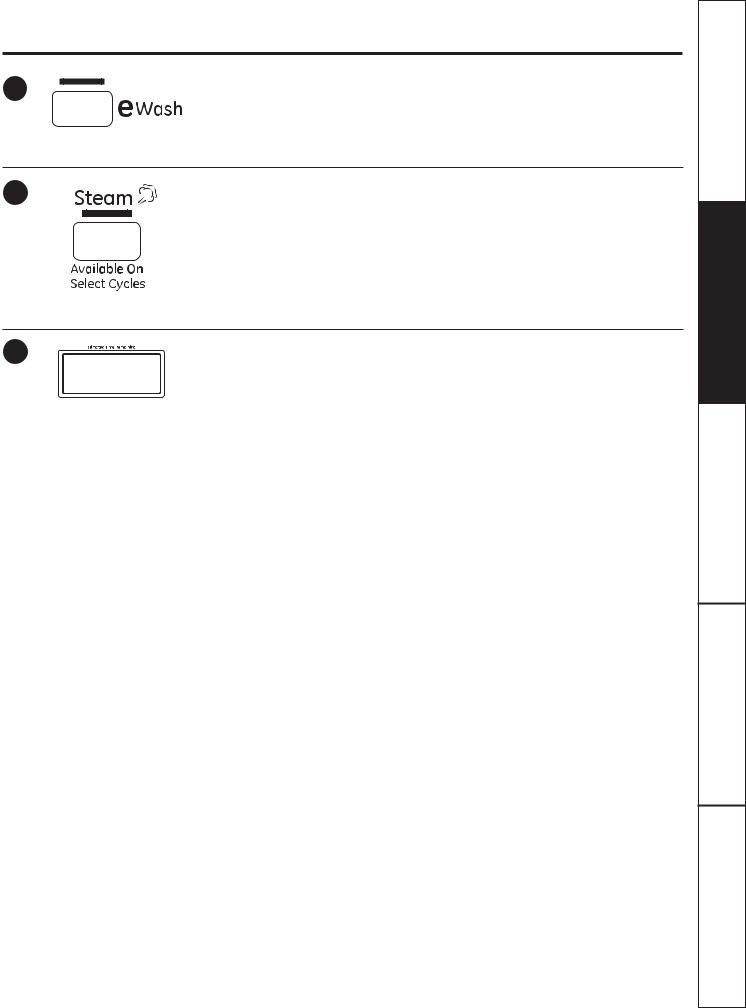
13
14
15
GEAppliances.com
eWash (Energy Saving Wash)
Use eWASH to save energy on specified wash cycles. eWASH cannot be used with Steam Refresh, Stain Wash or Basket Clean.
Steam (on some models)
Steam adds steam into the washer during Whites, Colors/Normals, Stain Wash, Sanitize or Bulky Bedding cycles.
To use:
1.Turn Power on and select a wash cycle.
The Steam option is only available on Whites, Colors/Normals, Stain Wash, Sanitize or Bulky Bedding cycles.
2.Press Steam pad to activate.
3.Press the Start pad.
Display
The display shows the approximate time |
NOTE: The cycle time is affected by how long |
remaining until the end of the cycle. |
it takes the washer to fill. This depends on the |
|
water pressure in your home. |
7
Instructions Operating Instructions Safety
Installation
Instructions
Support Consumer Tips Troubleshooting
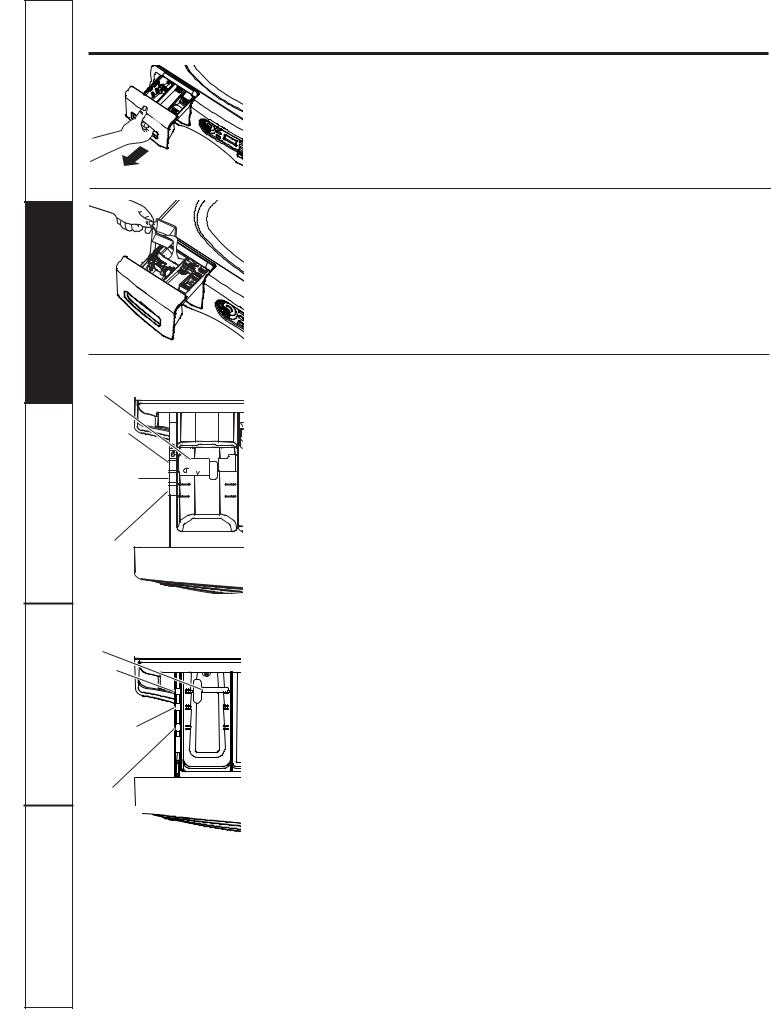
Operating Instructions Safety Instructions
Instructions
Installation
Consumer Support Troubleshooting Tips
About the washer features.
NOTE: Features may not be available on all washer models.
The Dispenser Drawer
Slowly open the dispenser drawer by pulling |
You may see water in the bleach and fabric |
it out until it stops. |
softener compartments at the end of the cycle. |
After adding laundry products, slowly close |
This is a result of the flushing/siphoning action |
the dispenser drawer. Closing the drawer too |
and is part of the normal operation of the |
quickly could result in early dispensing of the |
washer. |
bleach, fabric softener or detergent. |
|
The Prewash Compartment (on some models)
Only use the Prewash Compartment if you are selecting the Prewash cycle for heavily soiled clothes. Add measured detergent or prewash additive to the back left prewash compartment of the dispenser drawer.
Detergent or prewash additive is flushed from the dispenser in the prewash cycle (if selected).
NOTE: Liquid detergent will drain into the washer drum as it is added.
Detergent usage may need to be adjusted for water temperature, water hardness, size and soil level of the load. Avoid using too much detergent in your washer as it can lead to over sudsing and detergent residue being left on the clothes.
On some models: |
|
|
|
Remove for powder detergent |
|
||
Normal |
SHA |
|
|
HE Liquid |
|
|
|
W |
|
|
|
Detergent |
REP |
|
|
|
|
|
|
Setting |
1X |
remove for powder |
MAINWASH |
|
|||
2X HE Liquid |
LIQUID |
|
|
|
|
||
2X |
|
|
|
Detergent Setting 3X |
|
|
|
(most common |
|
|
|
setting) |
|
|
|
3X HE
Liquid
Detergent
Setting
Appearance may vary
On some models:
Remove for powder detergent
Normal |
|
|
|
HE Liquid |
|
|
|
Detergent |
1X |
remove for powder |
|
|
|
|
|
Setting |
2X |
|
|
2X HE Liquid |
3X |
|
|
Detergent Setting |
LIQUID |
|
|
(most common |
|
|
|
setting) |
|
|
|
|
|
DETERGENT |
SO |
The Detergent Compartment
High-efficiency detergent is required for this washer. Use the detergent manufacturer’s recommended amount.
The detergent selection insert must be placed in the detergent compartment in a specific position according to what type of detergent you are using.
Powder Detergent – Remove the detergent selection insert.
Liquid Detergent – You will need to adjust the insert according to the type of Liquid Detergent you are using. The Icons on the side of the detergent compartment must line up on the center when the insert is in position.
NOTE: Not all models have the 2x and 3x detergent settings. Some have only regular HE detergent settings. You must reduce the amount of detergent for 2x or 3x detergent per bottle instructions.
Move the insert by pulling it up and replace it by sliding it down between either the rear
or front detergent compartment molded rails, as desired, for liquid detergent. Remove for powder detergent.
Add measured detergent to the front left detergent compartment of the dispenser drawer.
Detergent is flushed from the dispenser at the beginning of the wash cycle. Either powdered or liquid detergent can be used.
Detergent usage may need to be adjusted for water temperature, water hardness,
size and soil level of the load. Avoid using too much detergent in your washer as it can lead to oversudsing and detergent residue being left on the clothes.
Using more detergent than the recommended quantity can cause residue buildup on your washer.
3X HE
Liquid
Detergent 
Setting
Appearance may vary
8
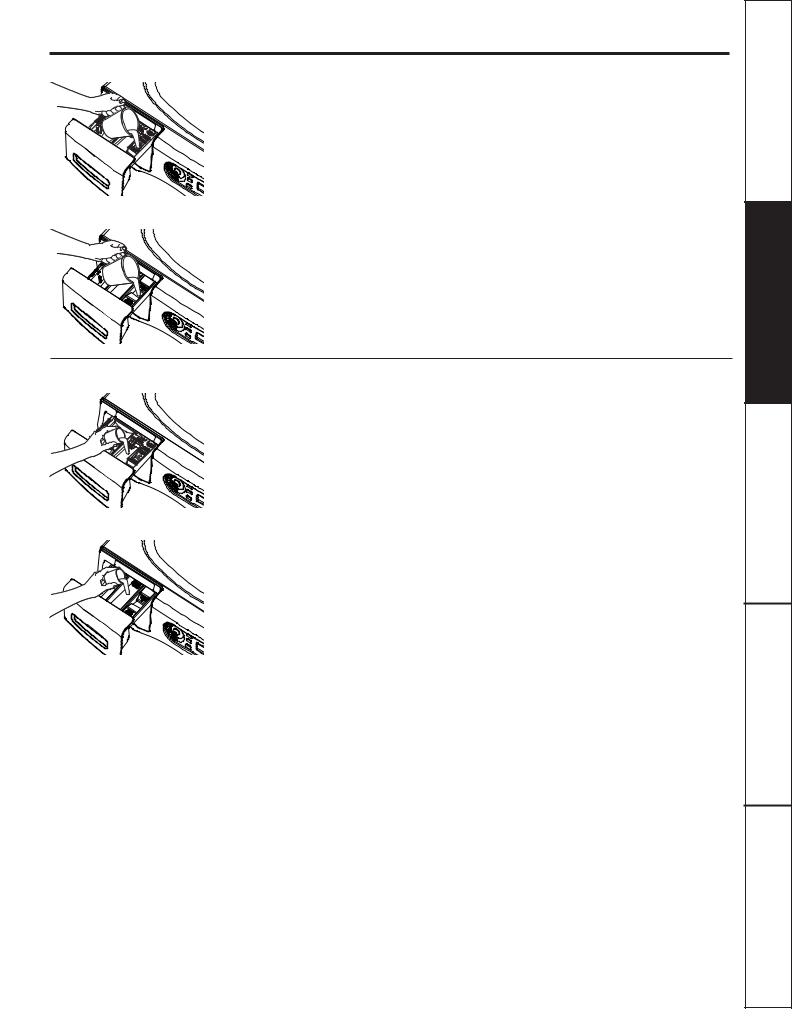
On some models:
On some models:
On some models:
On some models:
GEAppliances.com
The Liquid Bleach Compartment
IMPORTANT: The bleach compartment position varies by model. Be sure to identify the correct compartment for bleach before using.
If desired, measure out the recommended amount of liquid bleach, not to exceed 1/3 cup (80 ml), and pour into the right compartment labeled “LIQUID BLEACH”.
Do not exceed the maximum fill line. Overfilling can cause early dispensing of the bleach which could result in damaged clothes.
NOTE: Do not use powdered bleach in the dispenser.
The Fabric Softener Compartment
IMPORTANT: The fabric softener compartment position varies by model. Be sure to identify the correct compartment for fabric softener before using.
If desired, pour the recommended amount of liquid fabric softener into the compartment labeled “FABRIC SOFTENER.”
Use only liquid fabric softener in the dispenser.
Dilute with water to the maximum fill line.
Do not exceed the maximum fill line. Overfilling can cause early dispensing of the fabric softener which could stain clothes.
NOTE: Do not pour fabric softener directly on the wash load.
9
Instructions Operating Instructions Safety
Installation
Instructions
Support Consumer Tips Troubleshooting

Operating Instructions Safety Instructions
Instructions
Installation
Consumer Support Troubleshooting Tips
Loading and using the washer.
Always follow fabric manufacturer’s care label when laundering.
Sorting Wash Loads
Sort laundry into loads that can be washed together.
Colors |
Soil |
Fabric |
Lint |
Whites |
Heavy |
Delicates |
Lint Producers |
Lights |
Normal |
Easy Care |
Lint Collectors |
Darks |
Light |
Sturdy Cottons |
|
Combine large and small items in a load. Load large items first. Large items should not be more than half the total wash load.
Washing single items is not recommended. This may cause an out-of-balance load. Add one or two similar items.
Pillows and comforters should not be mixed with other items. This may cause an out-of-balance load.
 WARNING
WARNING 
 - Fire Hazard
- Fire Hazard
Never place items in the washer that are dampened with gasoline or other flammable liquids.
No washer can completely remove oil.
Do not dry anything that has ever had any type of oil on it (including cooking oils).
Doing so so can result in death, explosion, or fire.
Preparing Clothes
To avoid snags during washing:
Follow these steps to maximize garment care.
•Close garment zippers, snaps, buttons and hooks.
•Mend seams, hems, tears.
•Empty all items from pockets.
•Remove nonwashable garment accessories such as ornaments and nonwashable trim materials.
To avoid tangling, tie strings, draw ties and belt-like materials.
Brush away surface dirt and lint; treat spots and stains.
Promptly wash wet or stained garments to maximize results.
Mix garments using recommended maximum load sizes on page 11.
Use nylon mesh garment bags to wash small items.
Wash multiple garments at one time for best results.
10

GEAppliances.com
Loading the Washer
Wash drum may be fully loaded with loosely added items. Do not wash fabrics containing flammable materials (waxes, cleaning fluids, etc.).
To add items after washer has started, press Start and wait until the door is unlatched. The washer may take up to 30 seconds to unlock the door after pressing Start depending on the machine conditions. Do not try to force open the door when it is locked. After the door unlocks, open gently. Add items, close the door and press Start to restart.
Maximum Loading Sizes*
WORKWEAR |
LINENS |
MIXED LOAD |
DELICATES** |
SPEED WASH |
|
(2–4 GARMENTS) |
|||||
4 Jeans |
2 Bath Sheets |
4 Pillowcases |
7 Bras |
2 Casual Wear |
|
5 Workwear Shirts |
10 Bath Towels/ |
2 Hand Towels |
7 Panties |
Work Shirts |
|
1 Pair Casual Wear |
|||||
5 Workwear Pants |
12 Washcloths |
2 Flat Sheets/ |
3 Slips |
||
|
Work Pants |
||||
|
7 Hand Towels/ |
2 Fitted Sheets |
2 Camisoles |
||
|
|
||||
|
2 Terrycloth |
2 Bath Towels/ |
OR |
||
|
|
||||
|
Bath Mats |
4 Nightgowns |
|
||
|
4 Washcloths |
3 Soccer Uniforms |
|||
|
OR |
|
|||
|
OR |
|
|
||
|
2 Flat Queen-Sized |
|
|
||
|
6 Shirts (Men’s |
|
|
||
|
Sheets |
|
|
||
|
or Women’s) |
|
|
||
|
2 Fitted |
|
|
||
|
4 Pair Pants |
|
|
||
|
Queen-Sized |
|
|
||
|
(Khakis |
|
|
||
|
Sheets |
|
|
||
|
or Twills) |
|
|
||
|
4 Pillowcases |
|
|
||
|
5 T-Shirts |
|
|
||
|
|
|
|
||
|
|
7 Pairs of Boxers |
|
|
|
|
|
4 Pairs of Shorts |
|
|
|
|
|
OR |
|
|
|
|
|
6 T-Shirts |
|
|
|
|
|
4 Pairs of |
|
|
|
|
|
Sweatpants |
|
|
|
|
|
4 Sweatshirts |
|
|
|
|
|
2 Hoodies |
|
|
|
|
|
7 Pairs of Socks |
|
|
|
|
|
|
|
|
*Exceeding maximum recommended load sizes may affect cleaning performance and garment care. **Using a nylon mesh bag for small items is recommended.
11
Instructions Operating Instructions Safety
Installation
Instructions
Support Consumer Tips Troubleshooting
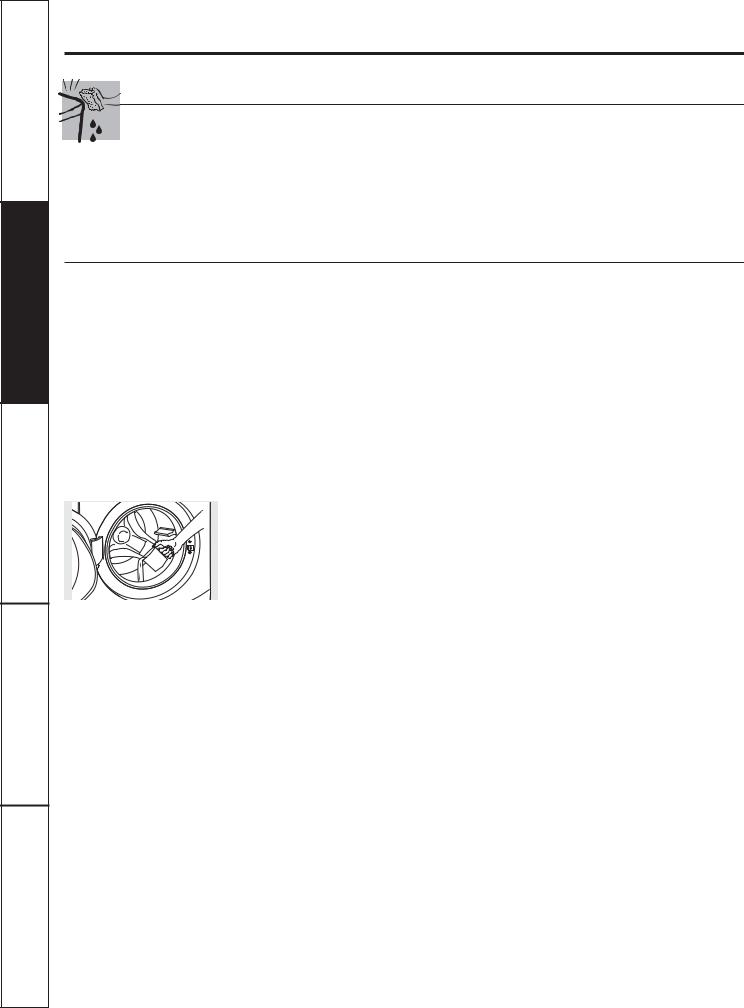
Operating Instructions Safety Instructions
Instructions
Installation
Consumer Support Troubleshooting Tips
Cleaning the washer.
Care and Cleaning
Exterior: Immediately wipe off any spills. Wipe with damp cloth. Do not hit surface with sharp objects.
Moving and Storage: Ask the service technician to remove water from drain pump and hoses. Do not store the washer where it will be exposed to the weather. When moving the washer, the tub should be kept stationary by using the shipping bolts removed during installation.
See Installation Instructions in this book. If these parts are not available, they can be ordered
by visiting our Website at GEAppliances.com or by calling 800.GE.CARES. In Canada, call 800.561.3344.
Long Vacations: Be sure the water supply is shut off at the faucets. Drain all water from the hoses if the weather will be below freezing.
Cleaning the Interior of the Washer
To clean the interior of the washer, select the Basket Clean feature on the control panel. The cycle will use more water,
in addition to bleach, to refresh your washer.
NOTE: Read the instructions below completely before starting the Basket Clean cycle.
1.Remove any garments or objects from the washer and ensure the washer basket is empty.
2.Open the washer door and pour one cup or 250 ml of liquid bleach or other washing machine cleaner into the basket.
3.Close the door and select the Basket Clean cycle. Push the Start pad.
4.When the Basket Clean cycle is working, you will see CLn on the display. The cycle will complete in about 90 minutes. Do not interrupt the cycle.
5.After the cycle is complete, leave the door open slightly for better ventilation.
If for any reason the cycle needs to be interrupted, the door will not open immediately. Forcing open the door at this stage may cause water to flood. The door will open after the water is drained to a level where it would not flood the floor.
Basket Clean may be interrupted
by pressing the Start pad in between cycles. A power outage in the house might also interrupt the cycle. When the power supply is back, the Basket Clean cycle resumes where it had stopped. When interrupted, be sure to run a complete Basket Clean cycle before using the washer. If the Power pad is pressed during BasketClean, the cycle will be lost.
IMPORTANT:
Run Basket Clean with 1 Cup (250 ml) of bleach once a month.
After the completion of a Basket Clean cycle, the interior of your washer may have a bleach smell.
It is recommended to run a light color load after the Basket Clean cycle.
12
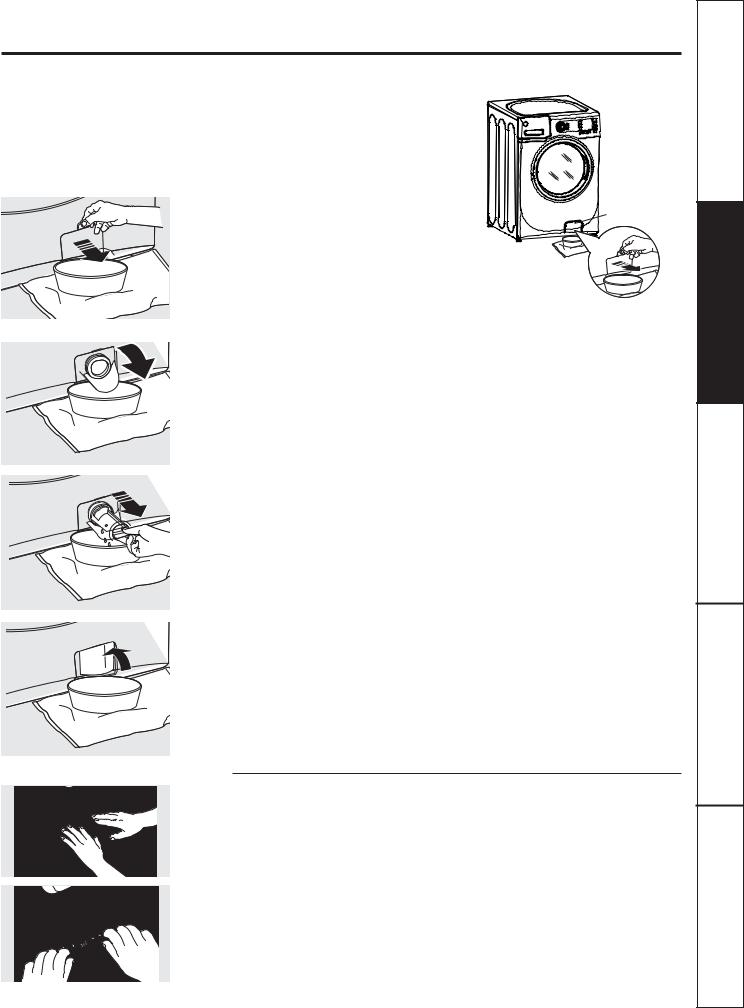
GEAppliances.com
Cleaning the Pump Filter
Pour  spout
spout 


Pour  spout
spout 



Due to the nature of the front-load washer, it is sometimes possible for small articles to pass to the pump. The washer has a filter to capture lost items so they are not dumped to the drain. To retrieve lost items, clean out the pump filter.
1. Using a coin or flat screwdriver |
Pump filter |
|
in the notch on the door, open |
||
|
||
the access door. |
|
2. Place a shallow pan or dish under the pump access door and towels on the floor in front of the washer to protect the floor. It is normal to catch about a cup of water when the filter is removed.
3.Pull down the pour spout.
4.Turn the pump filter counterclockwise and remove the filter. Open slowly to allow the water to drain.
5.Clean the debris from the filter.
6.Replace the filter and turn clockwise. Tighten securely.
7.Flip up the pour spout.
8.Close the access door.
Cleaning the Door Gasket
Open the washer door. Using both hands, press down the door gasket. Remove any foreign objects if found trapped inside the gasket. Make sure there is nothing blocking the holes behind the gasket.
While holding down the door gasket, inspect the interior gasket by pulling it down with your fingers. Remove any foreign objects if found trapped inside this gasket. Make sure there is nothing blocking the holes behind the gasket.
When you are finished cleaning the door gasket, remove your hands and the gasket will return to the operating position.
13
Instructions Operating Instructions Safety
Installation
Instructions
Support Consumer Tips Troubleshooting
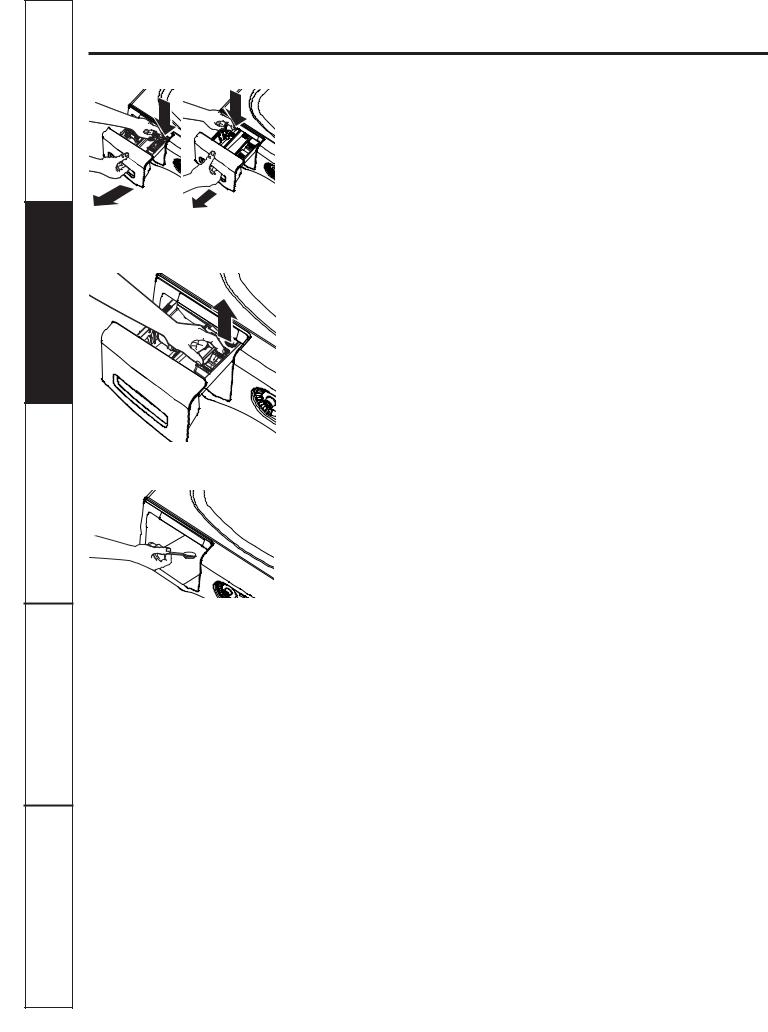
Operating Instructions Safety Instructions
Instructions
Installation
Consumer Support Troubleshooting Tips
Cleaning the washer.
Tabonbackrightorleftdependingonmodel Dispenser Drawer Area: Detergent and fabric softener may build up
in the dispenser drawer. Residue should be removed once or twice a month.
Remove the drawer by first pulling it out until it stops. Then reach back into the left or right rear corner (depending on model) of the drawer cavity and press down firmly on the lock tab, pulling out the drawer.
Lock tab is visible only after drawer has been pulled open
Remove the inserts from the bleach and fabric softener compartments and the detergent insert. Rinse the inserts and the drawer with hot water to remove traces of accumulated laundry products.
To clean the drawer opening, use a small brush to clean the recess. Remove all residue from the upper and lower parts of the recess.
Return inserts to the proper compartments. Replace the dispenser drawer.
14

Installation |
Washer |
Instructions |
|
If you have any questions, call 800.GE.CARES (800.432.2737) or visit our Website at: GEAppliances.com In Canada, call 800.561.3344 or visit GEAppliances.ca
BEFORE YOU BEGIN
Read these instructions completely and carefully.
• IMPORTANT – Save these instructions
for local inspector’s use.
• IMPORTANT – Observe all governing codes and ordinances.
• Note to Installer – Be sure to leave these instructions with the Consumer.
• Note to Consumer – Keep these instructions for future reference.
•Skill level – Installation of this appliance requires basic mechanical and electrical skills.
•Completion time – 1-3 hours
•Proper installation is the responsibility of the installer.
•Product failure due to improper installation is not covered under the Warranty.
FOR YOUR SAFETY:
 WARNING
WARNING
•This appliance must be properly grounded and installed as described in these Installation Instructions.
•Do not install or store the appliance in an area where it will be exposed to water/weather. See the Location of Your Washer section.
•NOTE: This appliance must be properly grounded, and electrical service to the washer must conform with local codes and ordinances and the latest edition of the National Electrical Code, ANSI/NFPA 70.
TOOLS REQUIRED
Adjustable wrench or 1/2” socket with ratchet
Adjustable wrench or 9/16” open-end wrench
Channel-lock adjustable pliers
Carpenter’s level
PARTS REQUIRED (Obtain locally)
Water Hoses (2)
PARTS SUPPLIED
Cable Tie |
|
Inlet Hose Screen |
Hose Guide |
Washers (2) |
|
STACK BRACKET KIT
A stack bracket kit is available at additional cost. It can be ordered in the United States by visiting our Web site at GEAppliances.com or calling 800.
GE.CARES. In Canada, call 800.661.1616 or visit your local GE Appliances dealer. Order kit # WE25X10018 or GEFLSTACK.
OPTIONAL PEDESTAL ACCESSORY
A pedestal is available at additional cost. It can be ordered in the United States by visiting our Web site at GEAppliances.com or calling 800.GE.CARES. In Canada, visit your local GE Appliances dealer. This product should be used with the pedestal # SBSD137HXX
and SBSD227FXX. Follow the pedestal Installation Instructions.
15
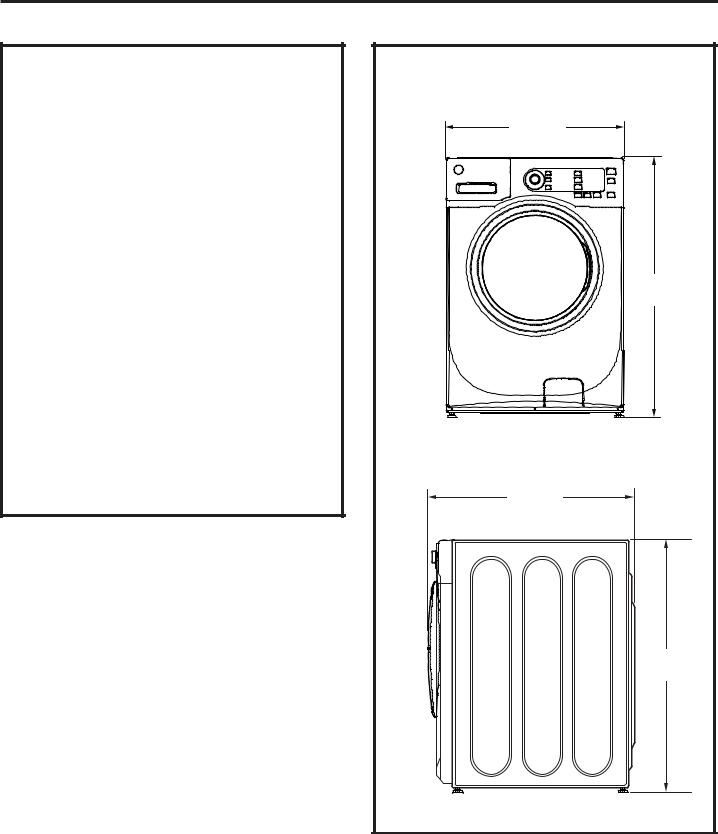
Installation Instructions
LOCATION OF YOUR WASHER
Do Not Install the Washer:
1.In an area exposed to dripping water or outside weather conditions. The ambient temperature should never be below 60°F (15.6°C) for proper washer operation.
2.In an area where it will come in contact with curtains or drapes.
3.On carpet. The floor MUST be a hard surface with a maximum slope of 1/2” per foot (1.27 cm per 30 cm). To make sure the washer does not vibrate or move, you may have to reinforce the floor.
NOTE: If floor is in poor condition, use 3/4” impregnated plywood sheet solidly attached to the existing floor covering.
IMPORTANT:
Minimum Installation Clearances
•When installed in alcove: Sides, Rear, Top = 0” (0 cm)
•When installed in closet: Sides, Rear, Top = 0” (0 cm), Front = 1” (2.54 cm)
•Closet door ventilation openings required:
2 louvers each 60 square in. (387 cm), located 3” (7.6 cm) from top and bottom of door
ROUGH-IN DIMENSIONS |
FRONT |
27.0” |
(68.6 cm) |
39.8” |
(101.09 cm) |
SIDE |
33.6” |
(85.3 cm) |
39.8” |
(101.09 cm) |
*NOTE: With pedestal, 52.6” |
Stacked, 84” |
16
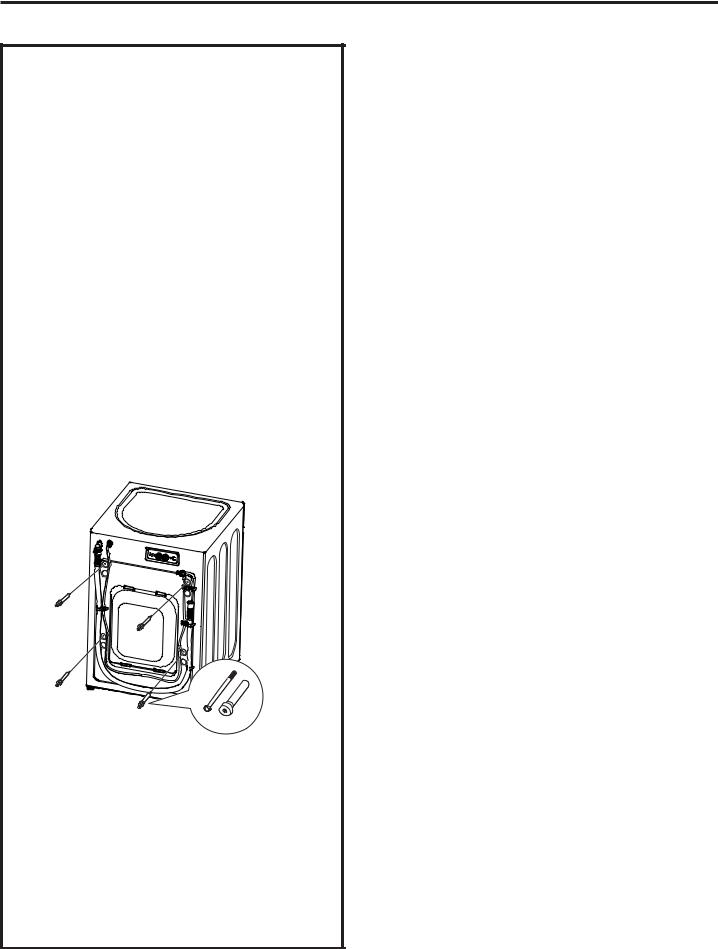
Installation Instructions
UNPACKING THE WASHER
 WARNING: Recycle or destroy the carton and plastic bags after the washer is unpacked. Make materials inaccessible to children. Children might use them for play. Cartons covered with rugs, bedspreads or plastic sheets can become airtight chambers causing suffocation.
WARNING: Recycle or destroy the carton and plastic bags after the washer is unpacked. Make materials inaccessible to children. Children might use them for play. Cartons covered with rugs, bedspreads or plastic sheets can become airtight chambers causing suffocation.
1.Cut and remove the top and bottom packaging straps.
2.While it is in the carton, carefully lay the washer on its side. DO NOT lay the washer on its front or back.
3. 7XUQGRZQWKHERWWRPIODSV³UHPRYHDOOEDVHSDFNDJLQJ including the cardboard, styrofoam base and styrofoam tub support (inserted in center of base).
NOTE: If you are installing a pedestal, proceed to
the installation instructions that come with the pedestal.
4.Carefully return the washer to an upright position and remove the carton.
5.Carefully move the washer to within 4 feet (122 cm) of the final location.
6.Remove the following from the back side of the washer: 4 bolts
4 plastic spacers (including rubber grommets)
4 power cord retainers
NOTE: Failure to remove the shipping braces can cause the washer to become severely unbalanced.
Save all bolts for future use.
NOTE: If you must transport the washer at a later date, you must reinstall the shipping support hardware to prevent shipping damage. Keep the hardware in the plastic bag provided.
In case you misplace your shipping bolts, replacements are available at additional cost. They can be ordered in the United States by visiting our website at GEAppliances.com
or calling 800.GE.CARES. In Canada, call 800.661.1616. Order kit #WH49X10039.
17
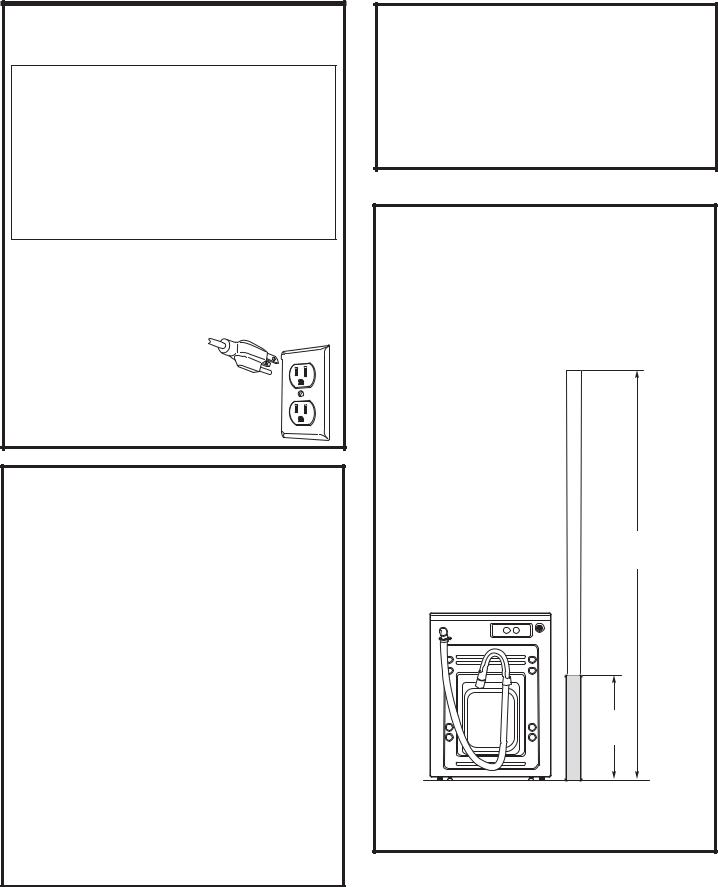
Installation Instructions
ELECTRICAL REQUIREMENTS
Read these instructions completely and carefully.
 WARNING:
WARNING:
TO REDUCE THE RISK OF FIRE, ELECTRICAL SHOCK AND PERSONAL INJURY:
•DO NOT USE AN EXTENSION CORD OR AN ADAPTER PLUG WITH THIS APPLIANCE.
Washer must be electrically grounded in accordance with local codes and ordinances, or in the absence of local codes, in accordance with the NATIONAL ELECTRICAL CODE, ANSI/NFPA NO. 70.
CIRCUIT – Individual, properly polarized and grounded 15-amp branch circuit fused with 15-amp time-delay fuse or circuit breaker.
POWER SUPPLY – 2-wire, with ground, 120-volt, single-phase, 60-Hz, alternating current.
OUTLET RECEPTACLE – Properly grounded 3-prong receptacle to be located so the power supply cord is accessible when the washer is in an installed position.
GROUNDING REQUIREMENTS
 WARNING:
WARNING:
Improper connection of the equipment grounding conductor can result in a risk of electrical shock. Check with a licensed electrician if you are in doubt as to whether the appliance is properly grounded.
1.The washer MUST be grounded. In the event of malfunction or breakdown, grounding will reduce the risk of electrical shock by providing a path of least resistance for electrical current.
2.Since your washer is equipped with a power supply cord having an equipment-grounding conductor and a grounding plug, the plug MUST be plugged into an appropriate, copper-wired receptacle that is properly installed and grounded in accordance with all local codes and ordinances or in the absence of local codes, with the National Electrical Codes, ANSI/NFPA 70 (latest edition). If in doubt, call a licensed electrician. DO NOT cut off or alter the grounding prong on the power supply cord. In situations where a two-slot receptacle is
present, it is the owner’s responsibility to have a licensed electrician replace it with a properly grounded three-prong grounding-type receptacle.
WATER SUPPLY REQUIREMENTS
Hot and cold water faucets MUST be installed within
42 inches (107 cm) of your washer’s water inlet. The faucets MUST be 3/4” (1.9 cm) garden hose-type so inlet hoses can be connected. Water pressure MUST be between 10 and 120 pounds per square inch. Your water department can advise you of your water pressure. The hot water temperature should be set to deliver water at 120° to 140°F (48°–60°C).
DRAIN REQUIREMENTS
1.Drain capable of eliminating 17 gals (64.3 L) per minute.
2.A standpipe diameter of 1–1/4” (3.18 cm) minimum.
3.The standpipe height above the floor should be:
Minimum height: 24” (61 cm) Maximum height: 96” (244 cm)
96” (244 cm) Max.
BACK
24” |
(61 cm) |
Min. |
NOTE: The drain hose attached to the washer can reach a 58” (147 cm) high standpipe. For a higher standpipe, contact an authorized parts distributor.
18
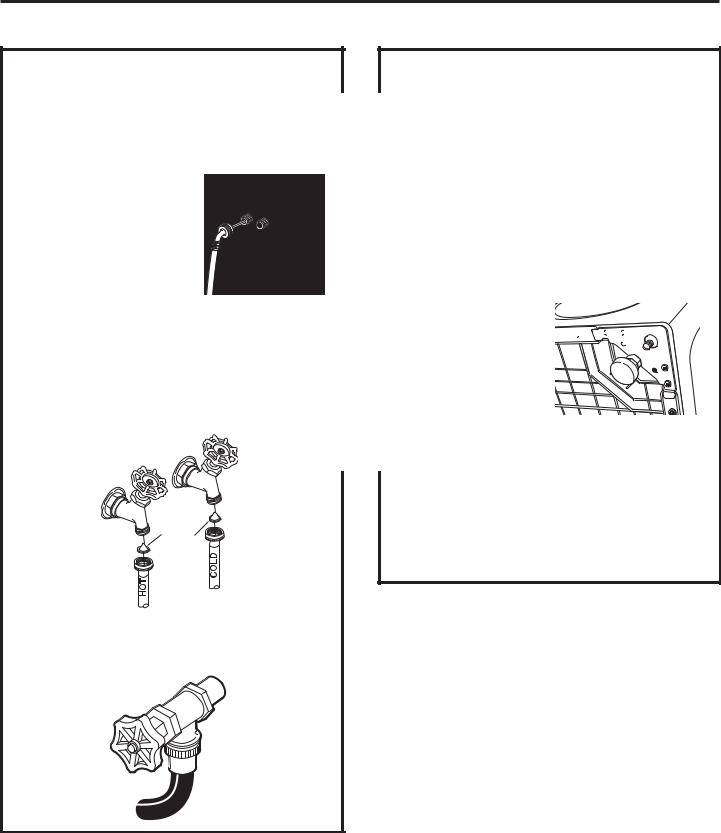
Installation Instructions
INSTALLING THE WASHER
1.Run some water from the hot and cold faucets to flush the water lines and remove particles that might clog up the inlet hoses and water valve screens.
2.Obtain inlet hoses locally.
3.Ensure there is a rubber washer in the hoses. Reinstall the rubber washer into the hose fitting if it has fallen out
during shipment. Carefully connect an inlet hose to
the outside “H” outlet of the
water valve. Tighten by hand, then tighten another 2/3 turn with pliers. Carefully connect
the other inlet hose to the inside “C” outlet of the water valve. Tighten by hand; then tighten another 2/3 turn with pliers. Do not crossthread or over-tighten these connections.
4.Install the screen washers by inserting them into the free ends of the inlet hoses with protruded side facing the faucet.
C
H
Inlet Hose
Screen
Washers
5.Connect the inlet hose ends to the HOT and COLD water faucets tightly by hand, then tighten another 2/3 turn with pliers. Turn the water on and check for leaks.
6.Carefully move the washer to its final location. Gently rock the washer into position ensuring inlet hoses do not become kinked. It is important not to damage the rubber leveling legs when moving your washer to its final location. Damaged legs can increase washer vibration. It may be helpful to spray window cleaner on the floor to help move your washer into its final position. NOTE: To reduce vibration, ensure that all four rubber leveling legs are firmly touching the floor. Push and pull on the back right and then back left of your washer.
NOTE: Do not use the dispenser drawer or door to lift the washer.
NOTE: If you are installing into a drain pan, you can use a 24-inch long 2x4 to lever the washer into place.
7. With the washer in its final position, place
a level on top of the 



 washer (if the washer
washer (if the washer 

is installed under a counter, the washer should not be able to
rock). Adjust the front leveling legs up or down
to ensure the washer is resting solid. Turn the lock nuts on each leg up towards the base of the washer and snug with a wrench.
NOTE: Keep the leg extension at a minimum to prevent excessive vibration. The farther out the legs are extended, the more the washer will vibrate.
If the floor is not level or is damaged, you may have to extend the rear leveling legs.
19
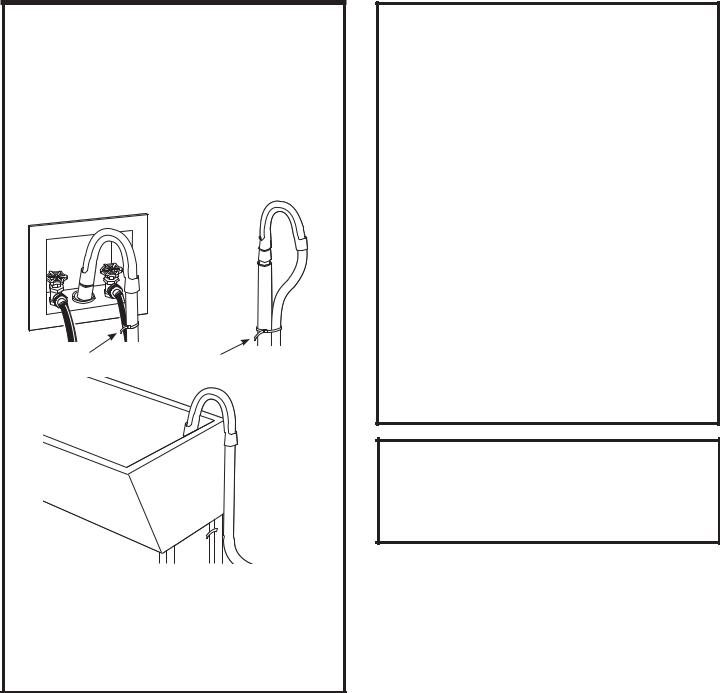
Installation Instructions
INSTALLING THE WASHER (cont.)
8.Attach the U-shaped hose guide to the end of the drain hose. Place the hose in a laundry tub or
standpipe and secure it with the cable tie provided in the enclosure package.
NOTE: Placing the drain hose too far down the drain pipe can cause a siphoning action. No more than 7 inches of hose should be in the drain pipe. There must be an air gap around the drain hose. A snug fit can also cause a siphoning action.
Cable Tie |
Cable Tie |

 Cable Tie
Cable Tie
9.Plug the power cord into a grounded outlet.
NOTE: Check to be sure the power is off at the circuit breaker/fuse box before plugging the power cord into an outlet.
10. Turn on the power at the circuit breaker/fuse box.
11. Read the rest of this Owner’s Manual. It contains valuable and helpful information that will save you time and money.
12. Before starting the washer, check to make sure:
Main power is turned on.
The washer is plugged in.
The water faucets are turned on.
The unit is level and all four leveling legs are firmly on the floor.
The shipping support hardware is removed and saved.
The drain hose is properly tied up.
There are no leaks at the faucet, drain line or washer.
13. Run the washer through a complete cycle. Check for water leaks and proper operation.
14.If your washer does not operate, please review the Before You Call For Service section before calling for service.
15. Place these instructions in a location near the washer for future reference.
REPLACEMENT PARTS
If replacement parts are needed for your washer, they can be ordered in the United States by visiting our Web site at GEAppliances.com or by calling 800.GE.CARES. In Canada, call 800.661.1616.
20

Before you call for service… GEAppliances.com
Troubleshooting Tips
Save time and money! Review the charts on the following pages first and you may not need to call for service.
Problem |
|
|
Possible Cause |
What To Do |
Not draining |
|
|
Load is out of balance |
• Redistribute clothes and run drain & spin or rinse & spin. |
Not spinning |
|
|
|
• Increase load size if washing small load containing heavy |
Not agitating |
|
|
|
and light items. |
|
|
|
|
|
|
|
|
Pump clogged |
• See page 13 on how to clean the Pump Filter. |
|
|
|
|
|
|
|
|
Drain hose is kinked or |
• Straighten drain hose and make sure washer is not |
|
|
|
improperly connected |
sitting on it. |
|
|
|
Household drain may |
• Check household plumbing. You may need to call |
|
|
|
be clogged |
a plumber. |
|
|
|
Drain hose siphoning; drain hose • Ensure there is an air gap between hose and drain. |
|
|
|
|
pushed too far down the drain |
|
|
|
|
|
|
Leaking water |
|
|
Door gasket is damaged |
• Check to see if gasket is seated and not torn. Objects |
|
|
|
|
left in pockets may cause damage to the washer (nails, |
|
|
|
|
screws, pens, pencils). |
|
|
|
Door gasket not damaged |
• Water may drip from the door when the door is opened. |
|
|
|
|
This is a normal operation. |
|
|
|
|
• Carefully wipe off rubber door seal. Sometimes dirt or |
|
|
|
|
clothing is left in this seal and can cause a small leak. |
|
|
|
Check back left of washer |
• If this area is wet, you have oversudsing condition. |
|
|
|
for water |
Use less detergent. |
|
|
|
Fill hoses or drain hose is |
• Make sure hose connections are tight at washer and |
|
|
|
improperly connected |
faucets and make sure end of drain hose is correctly |
|
|
|
|
inserted in and secured to drain facility. |
|
|
|
Household drain may |
• Check household plumbing. You may need to call |
|
|
|
be clogged |
a plumber. |
|
|
|
Dispenser clogged |
• Powder soap may cause clogs inside the dispenser and |
|
|
|
|
cause water to leak out the front of the dispenser. Remove |
|
|
|
|
drawer and clean both drawer and inside of dispenser box. |
|
|
|
|
Please refer to Cleaning the Washer section. |
|
|
|
Incorrect use of detergent |
• Use HE and correct amount of detergent. |
|
|
|
|
|
|
|
|
Dispenser box crack |
• If new installation, check for crack on inside of dispenser box. |
|
|
|
|
|
Clothes too wet |
|
|
Load is out of balance |
• Redistribute clothes and run drain & spin or rinse & spin. |
|
|
|
|
• Increase load size if washing small load containing heavy |
|
|
|
|
and light items. |
|
|
|
|
• The machine will slow the spin speed down to 410 rpm if |
|
|
|
|
it has a hard time balancing the load. This speed is normal. |
|
|
|
Pump clogged |
• See page 13 on how to clean the Pump Filter. |
|
|
|
|
|
|
|
|
Overloading |
• The dry weight of the load should be less then 16 lb. |
|
|
|
Drain hose is kinked or |
• Straighten drain hose and make sure washer is not |
|
|
|
improperly connected |
sitting on it. |
|
|
|
Household drain may |
• Check household plumbing. You may need to call |
|
|
|
be clogged |
a plumber. |
Drain hose siphoning; drain hose • Ensure there is an air gap between hose and drain. pushed too far down the drain
21
Instructions Operating Instructions Safety
Installation
Instructions
Support Consumer Tips Troubleshooting

Operating Instructions Safety Instructions
Instructions
Installation
Consumer Support Troubleshooting Tips
Before you call for service…
|
Problem |
|
|
|
Possible Cause |
What To Do |
|
|
|
|
|
|
|
|
Incomplete cycle or timer |
|
|
|
Automatic load redistribution |
• Timer adds 3 minutes to cycle for each rebalance. |
|
not advancing |
|
|
|
|
11 or 15 rebalances may be done. This is normal operation. |
|
|
|
|
|
|
Do nothing; the machine will finish the wash cycle. |
|
|
|
|
|
Pump clogged |
• See page 13 on how to clean the Pump Filter. |
|
|
|
|
|
|
|
|
|
|
|
Drain hose is kinked or |
• Straighten drain hose and make sure washer is not |
|
|
|
|
|
|
improperly connected |
sitting on it. |
|
|
|
|
|
Household drain may |
• Check household plumbing. You may need to call |
|
|
|
|
|
be clogged |
a plumber. |
|
|
|
|
|
Drain hose siphoning; drain hose • Ensure there is an air gap between hose and drain. |
|
|
|
|
|
|
pushed too far down the drain |
|
|
Loud or unusual noise; |
|
|
|
Cabinet moving |
• Washer is designed to move 1/4” to reduce forces |
|
vibration or shaking |
|
|
|
|
transmitted to the floor. This movement is normal. |
|
|
|
|
|
All rubber leveling legs are not |
• Push and pull on the back right and then back left of your |
|
|
|
|
|
firmly touching the floor |
washer to check if it is level. If the washer is uneven, adjust |
|
|
|
|
|
|
the rubber leveling legs so they are all firmly touching the |
|
|
|
|
|
|
floor and locked in place. Your installer should correct this |
|
|
|
|
|
|
problem. |
|
|
|
|
|
Unbalanced load |
• Open door and manually redistribute load. To check |
|
|
|
|
|
|
machine, run rinse and spin with no load. If normal, |
|
|
|
|
|
|
unbalance was caused by load. |
|
|
|
|
|
Pump clogged |
• See page 13 on how to clean the Pump Filter. |
|
|
|
|
|
|
|
|
No power/washer not |
|
|
|
Washer is unplugged |
• Make sure cord is plugged securely into a working outlet. |
|
working or dead |
|
|
|
|
|
|
|
|
|
Water supply is turned off |
• Turn both hot and cold faucets fully on. |
|
|
|
|
|
|
||
|
|
|
|
|
|
|
|
|
|
|
|
Circuit breaker/fuse is |
• Check house circuit breakers/fuses. Replace fuses or |
|
|
|
|
|
tripped/blown |
reset breaker. Washer should have separate outlet. |
|
|
|
|
|
Automatic self system checks |
• First time the washer is plugged in, automatic checks |
|
|
|
|
|
|
occur. It may take up to 20 seconds before you can use |
|
|
|
|
|
|
your washer. This is normal operation. |
|
Snags, holes, tears, rips |
|
|
|
Overloaded |
• Do not exceed maximum recommended load sizes. |
|
or excessive wear |
|
|
|
|
See recommended maximum load sizes on page 11. |
|
|
|
|
|
Pens, pencils, nails, screws or |
• Remove loose items from pockets. |
|
|
|
|
|
other objects left in pockets |
|
|
|
|
|
|
Pins, snaps, hooks, sharp |
• Fasten snaps, hooks, buttons and zippers. |
|
|
|
|
|
buttons, belt buckles, zippers |
|
|
|
|
|
|
and sharp objects left in pockets |
|
|
Control time wrong |
|
|
|
This is normal |
• During spin the washer may need to rebalance the load |
|
or changes |
|
|
|
|
sometimes to reduce vibrations. When this happens, |
|
|
|
|
|
|
the estimated time is increased causing time left to |
|
|
|
|
|
|
increase or jump. |
|
Not enough water |
|
|
|
This is normal |
• Horizontal washers do not require the tub to fill with water |
|
|
|
|
|
|
like top-load washers. |
|
Washer pauses or has |
|
|
|
Pump clogged |
• See page 13 on how to clean the Pump Filter. |
|
to be restarted, or washer |
|
|
|
|
|
|
door is locked and will |
|
|
|
|
|
|
not open |
|
|
|
|
|
|
Door unlocks or |
|
|
|
This is normal |
• Front-load washers start up differently than top-load |
|
press Start and machine |
|
|
|
|
washers, and it takes 30 seconds to check the system. |
|
doesn’t operate |
|
|
|
|
The door will lock and unlock. |
|
|
|
|
|
Incorrect operation |
• Simply open and close the door firmly; then press Start. |
|
|
|
|
|
|
|
22

|
|
|
|
|
|
GEAppliances.com |
|
|
|
|
|
|
|
|
|
|
|
|
|
|
|
|
|
|
|
Problem |
|
|
Possible Cause |
What To Do |
|
|
|
|
|
|
|
|
|
|
|
Water does not enter |
|
|
Automatic self system checks |
• After Start is pressed, the washer does several system |
|
|
|
washer or enters slowly |
|
|
|
checks. Water will flow 60 seconds after Start is pressed. |
|
|
|
|
|
|
Water supply is turned off |
• Turn on both hot and cold faucets fully. |
|
|
|
|
|
|
Water valve screens are |
• Turn off the water source and remove the water connection |
|
|
|
|
|
|
stopped up |
hoses from the upper back of the washer. Use a brush or |
|
|
|
|
|
|
|
toothpick to clean the screens in the machine. Reconnect |
|
|
|
|
|
|
|
the hoses and turn the water back on. |
|
|
|
|
|
|
|
|
|
|
|
|
|
|
Inlet hose screen washers are |
• Turn off the water source and remove the inlet hoses from |
|
|
|
|
|
|
stopped up |
the wall faucets. Use a brush or toothpick to clean the |
|
|
|
|
|
|
|
screen washers in the end of the hoses. Reconnect the |
|
|
|
|
|
|
|
hoses and turn the water back on. |
|
|
|
|
|
|
|
|
|
|
|
Wrinkling |
|
|
Improper sorting |
• Avoid mixing heavy items (like work clothes) with |
|
|
|
|
|
|
|
light items (like blouses). |
|
|
|
|
|
|
Overloading |
• Load your washer so clothes have enough room |
|
|
|
|
|
|
|
to move freely. |
|
|
|
|
|
|
Incorrect wash cycle |
• Match cycle selection to the type of fabric you are |
|
|
|
|
|
|
|
washing (especially for easy care loads). |
|
|
|
|
|
|
Repeated washing in |
• Wash in warm or cold water. |
|
|
|
|
|
|
water that is too hot |
|
|
|
|
|
|
|
|
|
|
|
|
Grayed or yellowed |
|
|
Not enough detergent |
• Use correct amount of detergent. |
|
|
|
clothes |
|
|
|
|
|
|
|
|
|
Not using HE (high-efficiency) |
• Use HE detergent. |
||
|
|
|
|
|
detergent |
|
|
|
|
|
|
|
Hard water |
• Use hottest water safe for fabric. |
|
|
|
|
|
|
|
• Use a water conditioner like Calgon brand or install |
|
|
|
|
|
|
|
a water softener. |
|
|
|
|
|
|
Water is not hot enough |
• Make sure water heater is delivering water at |
|
|
|
|
|
|
|
120°–140°F (48°–60°C). |
|
|
|
|
|
|
Detergent is not |
• Try a liquid detergent. |
|
|
|
|
|
|
dissolving |
|
|
|
|
|
|
|
Dye transfer |
• Sort clothes by color. If fabric label states wash separately, |
|
|
|
|
|
|
|
unstable dyes may be indicated. |
|
|
|
|
|
|
|
|
|
|
|
Colored spots |
|
|
Incorrect use of fabric |
• Check fabric softener package for instructions and follow |
|
|
|
|
|
|
softener |
directions for using dispenser. |
|
|
|
|
|
|
Dye transfer |
• Sort whites or lightly colored items from dark colors. |
|
|
|
|
|
|
|
• Promptly remove wash load from washer. |
|
|
|
|
|
|
|
||
|
|
Water temperature |
|
Water supply is improperly |
• Make sure hoses are connected to correct faucets. |
||
|
|
is incorrect |
|
connected |
|
|
|
|
|
|
|
House water heater is |
• Make sure house water heater is delivering water |
||
|
|
|
|
not set properly |
at 120°–140°F (48°–60°C). |
||
|
|
|
|
|
|
||
|
|
Slight variation |
|
This is normal |
• Due to the metallic properties of paint used for this unique |
||
|
|
in metallic color |
|
|
|
product, slight variations of color may occur due to viewing |
|
|
|
|
|
|
|
angles and lighting conditions. |
|
Bad odor inside |
Washer unused for a long time, |
your washer |
not using recommended |
|
quality of HE detergent |
|
or used too much detergent |
•Run a Basket Clean cycle.
•In the case of strong odor, you may need to run the Basket Clean cycle more than once.
•Use only the amount of detergent recommended on the detergent container.
•Use only HE (high-efficiency) detergent.
•Always remove wet items from the washer promptly after machine stops running.
•Leave the door slightly open for the water to air dry. Close supervision is necessary if this appliance is used by or near children. Do not allow children to play on, with or inside this or any other appliance.
23
Instructions Operating Instructions Safety
Installation
Instructions
Support Consumer Tips Troubleshooting

Operating Instructions Safety Instructions
Instructions
Installation
Consumer Support Troubleshooting Tips
Before you call for service…
|
|
Problem |
|
Possible Cause |
What To Do |
|
|
|
|
|
|
|
|
|
|
Detergent leak |
|
Incorrect placement of |
• Make sure detergent insert is properly located and fully |
|
|
|
|
|
detergent insert |
seated. Never put detergent above max line. |
|
|
|
Improper dispensing of |
|
Dispenser clogged |
• Monthly clean the dispenser drawer to remove buildup |
|
|
|
softener or bleach |
|
|
of chemicals. |
|
|
|
|
|
Softener or bleach is filled above |
• Make sure to have the correct amount of softener or bleach. |
|
|
|
|
|
the max line |
|
|
|
|
|
|
Softener or bleach cap issue |
• Make sure softener and bleach cap for dispenser are seated |
|
|
|
|
|
|
or they will not work. |
|
24
